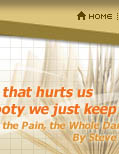When in Rome: A Journal of Life in Vatican City
by Robert J. Hutchinson
Overview
From the Publisher
When in Rome is a backstairs tour of one of the world's most mysterious and eccentric cities. Hutchinson introduces the varied and colorful individuals who live and work in the Vatican. In the process, he explores the mysterious orders of medieval knights, some dating back to the First Crusade, which still play a vital role in the Vatican; explains how bumbling Vatican archaeologists found, and then lost, the bones of St. Peter; probes the sex lives of the popes, from the "pornocracy" of Sergius III to the incestuous orgies of Rodrigo Borgia; experiences high fashion in the Holy See, including a visit to the pope's personal tailor; encounters the weird relics of Catholicism, such as the mummified body of St. Pius X and a museum made entirely out of human bones; recounts the true story behind the True Cross, now kept in a run-down church near the Colosseum; and much, much more.
My thoughts
I've just finished a few books on France so I thought I'd zip on over to Rome while I was in the neighborhood. You know by now that I love reading travelogues, so I thought we'd have a look at the Vatican City from the eyes of a tourist. I had a bit of trouble bonding with the author on this one, I'm afraid...
I really enjoyed the way he wrote about the sites he visited, and I enjoyed the way he told us how he traveled to get to the sites. I liked the way he described things and I liked the topics he chose to write about. The nagging feeling I have at the end of the book, however, is that he missed everything. He was there, he experienced it, but he didn't feel it. He didn't live it. Nothing seemed to touch him. As I closed the cover this evening having finished the book, I felt sorry for Mr. Hutchinson.
And that's left me feeling sad.
Favorite Passage
One late afternoon, when I was getting the usual runaround by a particularly smug Vatican priest, I decided to go visit the Scala Santa, or Holy Staircase...the twenty-eight marble steps up which Christ walked to see Pilate...For centuries, pilgrims have climbed these hard marble stairs -- on their knees. In 1723, Pope Innocent XIII had the stairs covered wtih walnut to keep them from being worn down...
I went in the main entrance and there, directly in front of me, were the five sets of steps, the middle one being covered with wood...But what amazed me most of all were the pilgrims.
Every few minutes, one or two pilgrims would approach, most of them under age forty, dip their hands in a holy water font at the base of the stairs, kneel down, and begin to climb the stairs on their knees. They would climb one step at a time, pause for a minute or two in silent prayer, and then climb another.
I was astonished. I was seized with a sudden, crazy thought to make the ascent, but, I'm ashamed to say, felt too embarrassed to perform such a crass act of pious devotion.
I'm not exactly the devotional type. My idea of devotion is reading Kierkegaard in front of a fire, a large snifter of warm cognac in hand. But what finally convinced me to have a go were all the kids. First a group of what looked like French eleven-year-olds arrived, and they went up. Then I saw four or five college kids and a young Asian woman in her mid-twenties. They went up. Then a young couple, holding hands, came. They went up.
Finally, I said to myself, what the hell? I knelt down on the first step. Following directly after me was a large group of German teenagers, obviously part of some pilgrimage group.
The first thing I noticed, once on the stairs, was that ... it hurt like a son of a bitch!
I mean, it really hurt. I've never felt anything quite like it. I've knelt down on marble floors of church before, during the Consecration, but the walnut wood covering these steps, with ridges and valleys centuries old, was far harder and more unforgiving than mere marble. Each movement of my legs was agony. Everywhere my knees touched burned. As I took my weight off one leg to move it up to the next step, putting all my weight on my other kneecap, the pain became excruciating. I quickly felt my calves begin to cramp up, and I started to sweat. I honestly felt, after just three or four steps, that I might not be able to make it. I was afraid I might pass out. Which astonished me to no end!...I pressed on...As you looked up at the large painting of Christ on the Cross, your knees in agony, you definitely spared a thought or two for what he must have gone through -- if not on this staircase then on one like it...Thirteen, twelve, eleven to go. My mind drifted back to the time I had spent in Jerusalem, to the dirty, urine-besotted Via Dolorosa, the Church of the Holy Sepulcher, the Kidron Valley with its dusty ancient tombs, the Garden of Gethsemane on the opposite side, the smell of diesel from the Egged buses. In the interest of journalistic accuracy, I tried to remember what the Roman Antonia fortress looked like in the scale model of first-century Jerusalem at the Holyland Hotel, and whether a staircase like this would have fit in it at all.
Six, five, four more left. Thank God!...Done. I dragged myself to my feet, bending over to massage my aching knees.
I thought once again about Luther. One of the last places he visited during his month in Rome was the Santa Scala. "In order to release my grandfather from purgatory, I climbed the stairs of Pilate, praying a Paternoster on each step, for it was the prevailing belief that whoever prayed in this way could free a soul," he wrote. Supposedly, halfway up the stairs Luther suddenly realized the futility and impiety of such a practice, stood up and walked out. The reformers liked to say that from that moment forward Luther understood he would have to seek God's grace elsewhere.
Perhaps. But having climbed those stairs on my knees myself, I now have a simpler explanation for Luther's sudden decision to quit halfway.
It hurt like hell!







